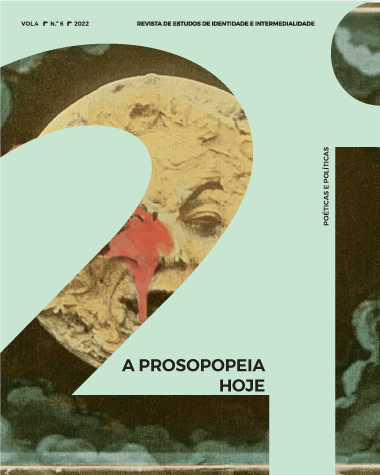Figure of the acousmatic voice
Prosopopoeia in 'What Where' (1986/2013) by Samuel Beckett
DOI:
https://doi.org/10.21814/2i.4100Keywords:
voice, figure, mask, alterity, acousmatic, BeckettAbstract
This article focuses on prosopopoeia as a “figure of the voice” in Samuel Beckett’s play for television What Where(1986/2013) and as it is defined by Bruno Clément. Prosopopoeia is a figure and a voice: both take part in the thought process. They allow the subject to think the thought process through self-hearing. Prosopopoeia is thus reflexive and participates in the phenomena of the mind which are carried out by the voice of the self, whose externalization gives way to an inner dialogue of sorts which is exposed to otherness. I will study this principle which is at the very heart of Beckett’s play along with the status of the voice. By being carried out by a figure of thought – prosopopoeia – the voice questions its origin through similarity and dissimilarity which highlights its equivocal nature. Indeed, if prosopopoeia is a figure that gives a voice to what has no existence, I will show that this voice is necessarily acousmatic.
Downloads
References
Artous-Bouvet, G. (2013) « Opérer par figures ». Critique, vol. 10 (797), 854-863.
Balique, F. (2014, Octobre). « La parole silencieuse de l’écriture ». Acta fabula, vol. 15 (8). http://www.fabula.org/revue/document8886.php
Beckett, S. (2006) « What Where ». In Complete Dramatic Works (pp. 467-476). London : Faber&Faber.
Chion, M. (1983). Guide des objets sonores : Pierre Schaeffer et la recherche musicale. Paris : Buchet-Chastel Institut national de la communication audiovisuelle.
Chion, M. (1982). La voix au cinéma. Paris : Éditions de l’Étoile, coll. « Cahiers du cinéma ».
Clément, B. (1994). L’Œuvre sans qualités : Rhétorique de Samuel Beckett. Paris : Seuil.
Clément, B. (2013). La voix verticale. Paris : Belin.
Deleuze, G. (1992). « L’Épuisé ». Quad et autres pièces pour la télévision suivi de L’Épuisé par Gilles Deleuze. Paris : Les Éditions de Minuit.
Dubois, Ph. (1999). « La question des Figures à travers le champ du savoir : Le savoir de la lexicologie : note sur Figura d’Erich Auerbach ». In Figure, figural (pp. 11-24). Paris : L’Harmattan.
Fehsenfeld, M. D. (1986). Beckett’s Reshaping of What Where for Television. Modern Drama, vol. 29 (2), 229-240.
Fontanier, P. (2009). Les figures du discours. Paris : Champs classiques.
Gontarski, S. (2012, October 9). What Where. Retrieved from https://www.youtube.com/watch?v=R8Dgtat_Inc
Kalb, J. (1989) Beckett in Performance. Cambridge : Cambridge UP.
Laurent M. et Campagnoni, D. P. (2009) Lanterne magique et film peint : 400 ans de cinéma, Paris : Éditions de La Martinière.
Montagne, V. (2008). La notion de prosopopée au XVIe siècle. Seizième Siècle, Société Française d’Étude du Seizième Siècle, 4, 217-236.
Noudelmann, F. (2022). La voix horizontale. In Figure, Voix, Pensée, pour Bruno Clément (pp. 263-276). Villeneuve d’Ascq : Presses universitaires du Septentrion.
Quintilien. (1865). De l’institut oratoire. In Quintilien et Pline Le Jeune, Œuvres Complètes (trad. Louis Baudet). (pp. 323-333). Paris : Collection des auteurs latins.
Rabelais, F. (1994a). Cinquiesme livre. In Œuvres complètes. Paris : Gallimard.
Rabelais, F. (1994b). Tiers livre. In Œuvres complètes. Paris : Gallimard.
Suhamy, H. (2016). Les figures de style. Paris : Presses Universitaires de France.
The Writing and Society Research Centre. (2016, April 5). What Where Film By Samuel Beckett - Film and Documentary. Retrieved from https://www.youtube.com/watch?v=R8Dgtat_Inc
Downloads
Published
How to Cite
Issue
Section
License
Copyright (c) 2022 Julie Bénard

This work is licensed under a Creative Commons Attribution-NonCommercial 4.0 International License.


.jpg)










